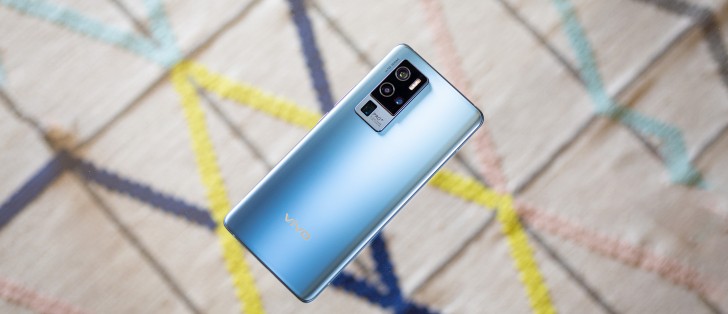vivo X50 Pro+ review

Fight! Vivo X50 Pro+ vs. Xiaomi Mi 10 Ultra
The vivo X50 Pro+ and the Xiaomi Mi 10 Ultra are the crème de la crème of the Chinese smartphones right now, and we just couldn't miss the opportunity to pit those two against each other in a camera battle.

Both phones are very capable shooters in broad daylight, that's for sure. But the Mi 10 Ultra captures more detail, and its photos are noticeably sharper. It also shows spot-on white balance, while the vivo goes for a bit warmer hues.




Main camera: Xiaomi Mi 10 Ultra
Next, we shot a couple of 5x zoomed photos with the long-range tele snappers. And what we observed with the primary cameras fully applies to the zoom snappers, too. While both phones save pretty good 5x photos, the Mi 10 Ultra's are noticeably superior in detail and color accuracy.
It's a different picture when the night falls. The X50 Pro+ often snapped more detailed photos - Xiaomi's noise reduction is more aggressive, and it smears some fine detail, while vivo's more gentle processing leaves more detail and tolerable noise.
But Xiaomi's low-light images are brighter, with better color accuracy and wider dynamic range.




Main camera: Xiaomi Mi 10 Ultra
When using Night Mode, both phones produce bright and detailed photos. Xiaomi's images are a bit better at everything though - resolved detail, exposure, and especially - white balance accuracy.




Night Mode: Xiaomi Mi 10 Ultra
Well, there you have it. While both flagships are excellent shooters, Xiaomi's processing turned out the more potent one and often returned more detailed photos with realistic colors.
Video quality assessment
The vivo X50 Pro+ captures video at up to 4320p@30fps with its main camera. The standard 2160p and 1080p resolutions are available, and you can choose between 30fps and 60fps. There is always-on electronic stabilization in addition to the optical one.
All other snappers can do 1080p@30fps and nothing else. If a 4K resolution or 60fps mode is selected, the 2x and 5x modes use the main camera and zoom digitally.
Oddly, if you switch to 8K mode, you can use both the main and the 2x zoom cameras, and yet you can't capture 4K with the zoom snapper.
Audio is always captured in stereo at 128kbps. You get to pick between the h.264 and h.265 codecs.
The 4K@30fps clips from the main camera are soft and with very limited dynamic range. The colors are accurate, and the contrast is good enough. They are steadier than the 60fps because of EIS but have a bit narrower field of view.
The 4K@60fps clips are shot without EIS, and thus they are sharper and with wider FoV - the picture wasn't cropped and upscaled back to 4K. The 60fps clips are indeed flagship-grade with superb detail, colors, and contrast. They are noise-free, too. The dynamic range is mediocre, though.
You can also shoot with the main at night, and if it isn't a pitch-dark scene, the footage will be pretty good.
The native 1080p@30fps videos from all four snappers are splendid - they are sharp with plenty of resolved detail, accurate colors, good dynamic range, and excellent contrast. Oddly, those videos were actually captured with 25fps instead of 30fps, which was unexpected and that's the reason they may appear a bit choppy.
The 1080p@60fps footage from the main camera isn't missing any frames, and it's as great as the rest of the 1080p bunch.
You can capture 8K clips at 30fps with the main and the 2x snappers. The footage looks upscaled from lower resolution though, soft and full of Bayer artifacts, and we simply don't recommend using any of the 8K modes.
Electronic stabilization is available for all snappers in all resolutions at 30fps.
Finally, closing this camera section off, here is the vivo X50 Pro+ in our video comparison database.



vivo X50 Pro+ against the vivo X50 Pro and the Xiaomi Mi 10 Ultra in our Video compare tool
Reader comments
- Anonymous
- 05 Mar 2021
- gBV
I think it could be maybe indeed possible to achieve a slightly(!) higher resolution with Quad Bayer dual pixel sensors than with Quad Bayer sensors (by using a super resolution algorithm), but it seems that Vivo doesn't do that.
- Anonymous
- 19 Feb 2021
- gBV
Samsung, you promised that the GN1 sensor can take 100 megapixel photos, so just a marketing lie?Samsung said "Samsung also provides a software algorithm that takes light information from each photodiode to produce image resolutions comparable t...
- aquinoe
- 04 Feb 2021
- 0p}
Hi. Great camera... but I'm still curious if you can improve photo quality using a Gcam port, specially on ultrawide and telephoto. Has anyone been able to found such a multicamera conscious Gcam?



















